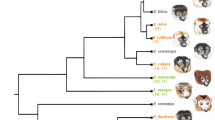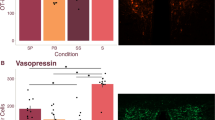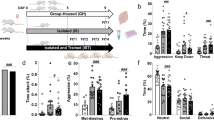Abstract
Arginine vasopressin influences male reproductive and social behaviours in several vertebrate taxa1 through its actions at the V1a receptor in the brain. The neuroanatomical distribution of vasopressin V1a receptors varies greatly between species with different forms of social organization2,3. Here we show that centrally administered arginine vasopressin increases affiliative behaviour in the highly social, monogamous prairie vole, but not in the relatively asocial, promiscuous montane vole. Molecular analyses indicate that gene duplication and/or changes in promoter structure of the prairie vole receptor gene may contribute to the species differences in vasopressin-receptor expression. We further show that mice that are transgenic for the prairie vole receptor gene have a neuroanatomical pattern of receptor binding that is similar to that of the prairie vole, and exhibit increased affiliative behaviour after injection with arginine vasopressin. These data indicate that the pattern of V1a-receptor gene expression in the brain may be functionally associated with species-typical social behaviours in male vertebrates.
This is a preview of subscription content, access via your institution
Access options
Subscribe to this journal
Receive 51 print issues and online access
$199.00 per year
only $3.90 per issue
Buy this article
- Purchase on Springer Link
- Instant access to full article PDF
Prices may be subject to local taxes which are calculated during checkout




Similar content being viewed by others
References
Young, L. J., Wang, Z. & Insel, T. R. Neuroendocrine bases of monogamy. Trends Neurosci. 21, 71–75 (1998).
Bester-Meredith, J. K., Young, L. J. & Marler, C. A. Species differences in paternal behavior and aggression in Peromyscus and their associations with vasopressin immunoreactivity and receptors. Horm. Behav.(in the press).
Insel, T. R., Wang, Z. & Ferris, C. F. Patterns of brain vasopressin receptor distribution associated with social organization in microtine rodents. J. Neurosci. 14, 5381–5392 (1994).
Ritters, L. V. & Panksepp, J. Effects of vastotocin on aggressive behavior in male Japanese quail. Ann. NY Acad. Sci. 807, 478–480 (1997).
Ferris, C. F. et al. Vasopressin/serotonin interactions in the anterior hypothalamus control aggressive behavior in gold hamsters. J. Neurosci. 17, 4331–4340 (1997).
Young, L. J., Winslow, J. T., Nilsen, R. & Insel, T. R. Species differences in V1areceptor gene expression in monogamous and non-monogamous voles: behavioral consequences. Behav. Neurosci. 111, 599–605 (1997).
Moore, F. L. & Miller, L. J. Arginine vasotocin induces sexual behavior of newts by acting on cells in the brain. Peptides 4, 97–102 (1983).
Winslow, J., Hastings, N., Carter, C. S., Harbaugh, C. & Insel, T. Arole for central vasopressin in pair bonding in monogamous prairie voles. Nature 365, 545–548 (1993).
Ferris, C. F. & Potegal, M. Vasopressin receptor blockade in the anterior hypothalamus suppresses aggression in hamsters. Physiol. Behav. 44, 235–239 (1988).
Barberis, C. & Tribollet, E. Vasopressin and oxytocin receptors in the central nervous system. Crit. Rev. Neurobiol. 10, 119–154 (1996).
Shapiro, L. E. & Dewsbury, D. A. Differences in affiliative behavior, pair bonding, and vaginal cytology in two species of vole (Microtus ochrogaster and M. montanus). J. Comp. Psychol. 104, 268–274 (1990).
Bamshad, M., Novak, M. & DeVries, G. J. Cohabitation alters vasopressin innervation and paternal behavior in prairie voles. Physiol. Behav. 56, 751–758 (1994).
Wang, Z., Smith, W., Major, D. E. & De Vries, G. J. Sex and species differences in the effects of cohabitation on vasopressin messenger RNA expression in the bed nucleus and stria terminalis in prairie voles (Microtus orchogaster) and meadow voles (Microtus pennsylvanicus). Brain Res. 650, 212–218 (1994).
Wang, Z., Ferris, C. F. & De Vries, G. J. Role of septal vasopressin innervation in paternal behavior in prairie voles (Microtus ochrogaster). Proc. Natl Acad. Sci. USA 91, 400–404 (1994).
Choong, C. S., Kemppainen, J. A., Zhou, Z. & Wilson, E. M. Reduced androgen receptor gene expression with first exon CAG repeat expansion. Mol. Endrocrinol. 10, 1527–1535 (1997).
Klesert, T. R., Otten, A. D., Bird, T. D. & Tapscott, S. J. Trinucleotide repeat expansion at the myotonin dystrophy locus reduces expression of DMAHP. Nature Genet. 16, 402–406 (1997).
Meloni, R., Albanése, V., Ravassard, P., Treilhou, F. & Mallet, J. Atetranucleotide polymoric microsatellite, located in the first intron of the tyrosine hydroxylase gene, acts as a transcription regulatory element in vitro. Hum. Mol. Gen. 7, 423–428 (1998).
Barberis, C. et al. Characterization of a novel, linear radioiodinated vasopressin antagonist: an excellent radioligand for vasopressin V1areceptors. Neuroendocrinol. 62, 135–146 (1995).
Acknowledgements
This work was supported by grants from the NIMH and NCRR to L.J.Y. and T.R.I.
Author information
Authors and Affiliations
Corresponding author
Rights and permissions
About this article
Cite this article
Young, L., Nilsen, R., Waymire, K. et al. Increased affiliative response to vasopressin in mice expressing the V1a receptor from a monogamous vole. Nature 400, 766–768 (1999). https://doi.org/10.1038/23475
Received:
Accepted:
Issue Date:
DOI: https://doi.org/10.1038/23475
This article is cited by
-
Leveraging a translational research approach to drive diagnostic and treatment advances for autism
Molecular Psychiatry (2022)
-
Evolution of central neural circuits: state of the art and perspectives
Nature Reviews Neuroscience (2022)
-
Comparative neurotranscriptomics reveal widespread species differences associated with bonding
BMC Genomics (2021)
-
Social effects on AVT and CRF systems
Fish Physiology and Biochemistry (2021)
-
Pharmacological Manipulation of the Circadian Clock: A Possible Approach to the Management of Bipolar Disorder
CNS Drugs (2019)
Comments
By submitting a comment you agree to abide by our Terms and Community Guidelines. If you find something abusive or that does not comply with our terms or guidelines please flag it as inappropriate.



